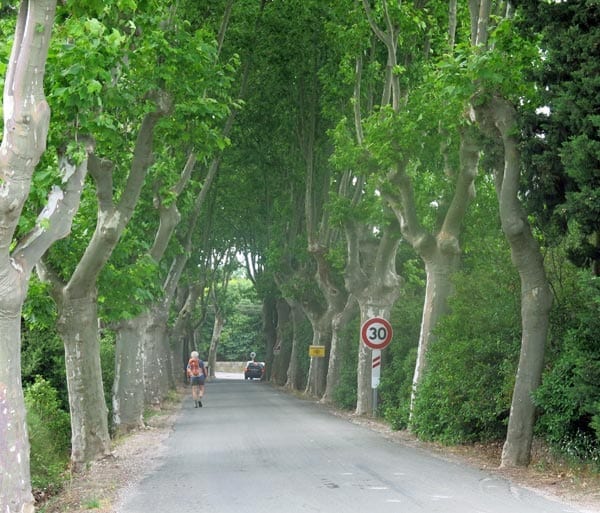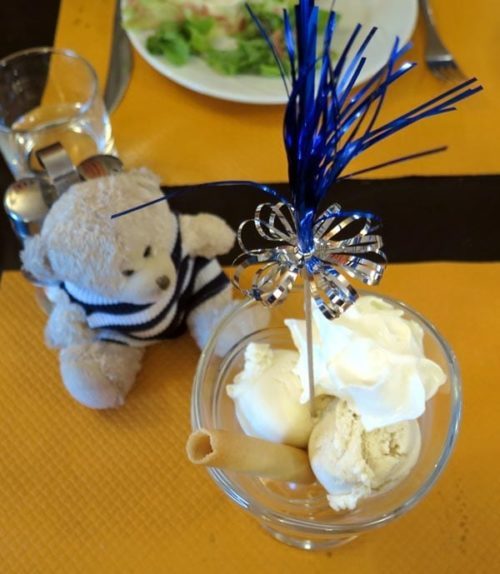
Saturday, 13 June 2015
Distance 22 km
Duration 5 hours 55 minutes
Ascent 532 m, descent 571 m
Map 174 of the TOP100 lime-green series
As is our habit when staying in hotels (but never when camping), we had showers before getting dressed.
Keith ventured into the street to look for a bar, but they were all closed until at least nine o’clock. That is one of the hazards of tourist villages – in non-touristy Fabrezan, by contrast, the bar opened at half past six.
All was not lost, however, thanks to the electric jug in the room, and the fact that boulangeries always open early. Keith went out again and came back with two croissants and a pain aux raisins, which made a very nice breakfast with Nescafé and powdered milk.

Thus armed against starvation, we set out just after seven. Once over the bridge, we took the D3 around the curve of the river, turning off after a kilometre or so to cross a tributary on an arched stone bridge, the little brother of the one in Lagrasse.
The road then climbed through a forest of pines and we came to an imposing farmhouse – le Château des Auzines.
Here the bitumen ended in a fan of small dirt roads, but luckily we were on the GR36, and the red and white marks guided us past the vines, along a ridge and out into open country.

Morning mist still hung over the land and the walking was almost effortless, fuelled as we were by a good breakfast.
We were on a high, grassy moorland scattered with stocky trees, extending out of sight into the haze.
As we swung along, we happened to notice a red and white cross (wrong way – go back) painted on a flat rock in the middle of the track.
The GR had diverged from the wheel track onto a much smaller path and we had walked blindly past the turning signs.
Quickly retracing our steps, we took this stony little path, which rose abruptly through rough grassland. Since we were now paying attention, we did not miss the GR turning signs on a couple of sudden bends.


At the crest of the range, the view opened out gloriously below us – a wide valley of vines, with the village of Montlaur at the foot of a wooded spur.
The way down, through a patch of pines, was trouble-free and as we entered the town we joined the D114, a fine boulevard with plane trees on one side and the school and church on the other.

Between these two handsome buildings we saw a bar, but to our disgust the roller door was down and it looked as if it would never rise again, so we sat disconsolately on a seat and ate a few dried peaches instead of the coffee that we had promised ourselves.
Our route from there was past the closed bar, beyond which was a Vival supermarket with a board listing all the services they provided.
At the bottom of the list we noticed “café”, so we hurried in and discovered a coffee machine in a corner of the shop, which dispensed little plastic cups of coffee for 60c.
We sat down amongst the fruit and vegetables with these unexpected treats, beaming at the other customers and feeling very pleased with ourselves.

At last we set off, following the GR marks up and out of the village, around a small knoll and onto a stony wheel track.
It was a delightful walk amongst rounded hills clad in tough, aromatic garrigue plants, interspersed with vineyards like blankets of green corduroy.

After a while Keith started to wonder why there were no more GR marks, but we were reassured when we came to a house, which we assumed was the one marked on our map, at Roquenégade.
The trouble was that the track that was supposed to continue past the house did not seem to exist and the contours were all wrong. In the end we gave up and went back to knock on the door.
A woman appeared, but when we said we were lost, she waved us away declaring ”Je suis Anglais!”.

She was very relieved when we broke into English, and tried her best to work out where we were on our map. Eventually she noticed the half-word “-isir” on the edge of the map – her place was called Montplaisir. We could see that we had missed the point where the GR left the wheel track and had continued along it to her house.
With many thanks to this helpful woman (who, like many expatriates, had such a tan that she looked like a piece of gnarled, polished wood) we retraced our steps and found where we had gone wrong. It was obvious now.
After it left the wheel track, the GR became a narrow, bushy path descending sharply to the valley which, needless to say, was carpeted with vines. This was really Roquenégade.
Here we parted with the GR, which went off along the valley, and began the climb up the other side. There were dusty little tracks branching off in all directions and it was more guesswork than science that got us onto the right path.

Higher up it became surprisingly well defined as we clambered through the forest beside a tumbling stream. Evidently it was a traditional route into the valley of the Aude.
The forest around us was full of the spicy smell of leaves and the whistling, chirruping, whirring and clicking sounds of hidden life. We were pleased to be out of earshot of the gloomy doves that haunt most of France.
The more we climbed, the rockier and more deeply eroded the track became, until we were scrambling at every step. On the saddle we crossed another branch of the GR36 and started to descend.
The gradient was gentler now and we felt that our labours were over, but pretty soon the track reverted to the rocky, vertiginous trench that it had been.

When we arrived at the road crossing, we could not find the continuation of our plunging track, so we turned onto the bitumen, around a big hairpin bend, expecting to pick up the track lower down, but it had completely disappeared in a mass of brambles. The rest of the descent we made on the road, which was longer but quite a relief.
The graceful spire of the church of Capendu was visible as we came down to the autoroute underpass. Then there was a classic avenue of plane trees before we crossed the railway line and entered the town.
We quickly realised that we had already seen the best of it from a distance – up close it was sadly run-down with many closed shops, perhaps the result of the autoroute killing its passing trade (on the other hand, they may simply have been closed for lunch, as it was Saturday afternoon).
We came to a bar, but it too was closed, and the streets were deserted. We knew that there was no camping here, only a hotel, le Top du Roulier. As we stood consulting our map a young fellow wobbled up on his bike, balancing a cello on the handlebars, and stopped to help us get our bearings. Soon we were out on the highway (the N113), where we found the modest gateway to the hotel amidst a line of buildings.

As we turned through the gate we entered another universe. The hotel building, with its whitewashed walls and arched arcade, curved around a spacious courtyard dominated by an ancient, twisted olive tree.
There were citrus trees in big tubs, bar tables set on barrels and dining tables under an awning, where a few people were still eating lunch. It was a wonderfully cheering sight and before long we were installed in an upstairs room, looking out over the scene.
The room was large, the bathroom magnificent and the bed utterly luxurious. We found out later that this hotel was very old, and famous in the district.
Having slept away the rest of the afternoon, we stepped down to the courtyard for apéritifs. While we were there the chef came out and snipped some chives and rosemary from the base of the olive tree, both of which later appeared as garnish on our plates.

By dinner time it was getting too cool to eat outside, so we retired to the warmth of the dining room, where we had a table against the window looking out on the courtyard – the best of both worlds. The meal was a delightful contrast with the starvation rations of last night (and cheaper – €43 instead of €55).
We started with a mise en bouche of tiny fish with pesto on toast. Then our entrées were a tomato and mozzarella salad for Keith and a salade aux gésiers for me, each twice the size of the miserable scrap of rocket that we had shared at Lagrasse.

For mains, Keith had pork cheek with a creamy sauce, and I had a beef and olive ragout. There was plenty of bread and the wine came in a carafe.

Then Keith had icecream impaled with a shiny blue tassel, and I had cheese, which I stowed away for another occasion.
On our way back to our room we booked ourselves in for breakfast the following morning – the waitress promised that it would be a good spread.
Previous day: Fabrezan to Lagrasse